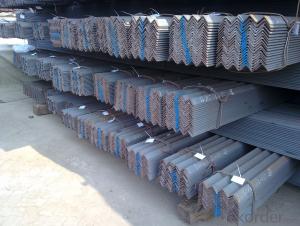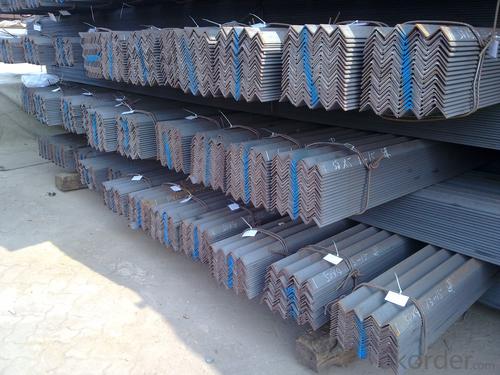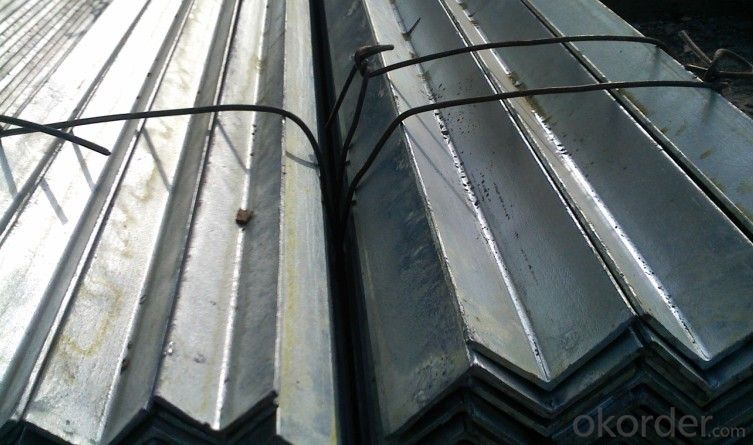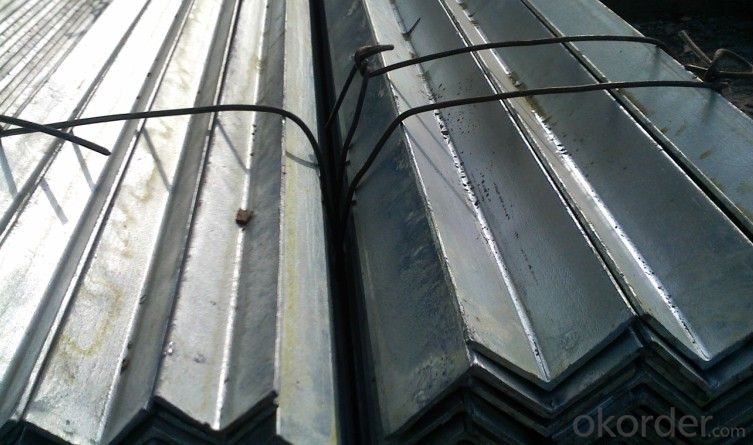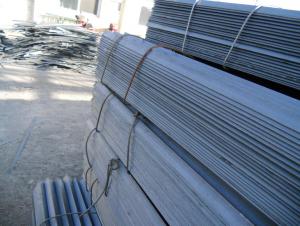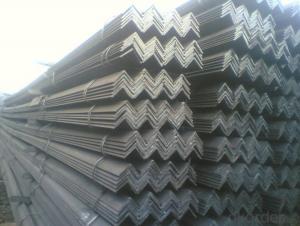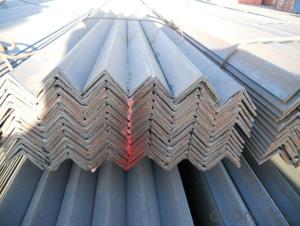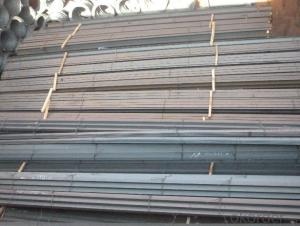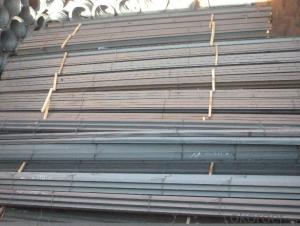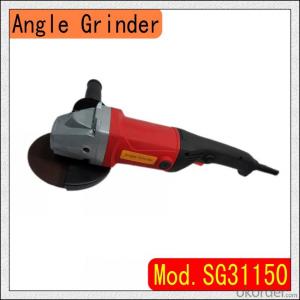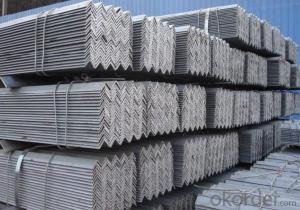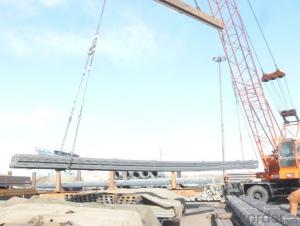ANGLE
- Loading Port:
- China Main Port
- Payment Terms:
- TT OR LC
- Min Order Qty:
- -
- Supply Capability:
- -
OKorder Service Pledge
OKorder Financial Service
You Might Also Like
Specifications of Angle Steel
1. Invoicing on theoretical weight or actual weight as customer request
2. Length: 6m, 9m, 12m as following table
3. Sizes
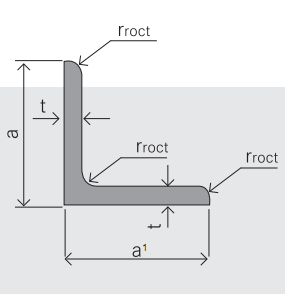
Sizes: 25mm-250mm | ||
a*t | ||
25*2.5-4.0 | 70*6.0-9.0 | 130*9.0-15 |
30*2.5-6.6 | 75*6.0-9.0 | 140*10-14 |
36*3.0-5.0 | 80*5.0-10 | 150*10-20 |
38*2.3-6.0 | 90*7.0-10 | 160*10-16 |
40*3.0-5.0 | 100*6.0-12 | 175*12-15 |
45*4.0-6.0 | 110*8.0-10 | 180*12-18 |
50*4.0-6.0 | 120*6.0-15 | 200*14-25 |
60*4.0-8.0 | 125*8.0-14 | 250*25 |
5. Payment terms:
1).100% irrevocable L/C at sight.
2).30% T/T prepaid and the balance against the copy of B/L.
3).30% T/T prepaid and the balance against L/C
6.Material details:
Alloy No | Grade | Element (%) | | ||||
C | Mn | S | P | Si | | ||
| | |||||||
|
|
|
|
|
|
| |
Q235 | B | 0.12—0.20 | 0.3—0.7 | ≤0.045 | ≤0.045 | ≤0.3 | |
|
|
|
|
|
|
| |
Alloy No | Grade | Yielding strength point( Mpa) | | ||||
Thickness (mm) | | ||||||
≤16 | >16--40 | >40--60 | >60--100 | | |||
≥ | | ||||||
|
|
|
|
|
| | |
Q235 | B | 235 | 225 | 215 | 205 | | |
Alloy No | Grade | Tensile strength (Mpa) | Elongation after fracture (%) | | |||
Thickness (mm) | | ||||||
| ≤16 | >16--40 | >40--60 | >60--100 | | ||
≥ | | ||||||
|
|
|
|
|
|
| |
Q235 | B | 375--500 | 26 | 25 | 24 | 23 | |
Usage & Applications of Angle Steel
According to the needs of different structures, Angle can compose to different force support component, and also can be the connections between components. It is widely used in various building structures and engineering structures such as roof beams, bridges, transmission towers, hoisting machinery and transport machinery, ships, industrial furnaces, reaction tower, container frame and warehouse etc.
Packaging & Delivery of Angle Steel
1. Packing: it is nude packed in bundles by steel wire rod
2. Bundle weight: not more than 3.5MT for bulk vessel; less than 3 MT for container load
3. Marks:
Color marking: There will be color marking on both end of the bundle for the cargo delivered by bulk vessel. That makes it easily to distinguish at the destination port.
Tag mark: there will be tag mark tied up on the bundles. The information usually including supplier logo and name, product name, made in China, shipping marks and other information request by the customer.
If loading by container the marking is not needed, but we will prepare it as customer request.
Production flow of Angle Steel
Material prepare (billet) —heat up—rough rolling—precision rolling—cooling—packing—storage and transportation
- Q: How do you determine the required angle size for a specific application?
- To determine the required angle size for a specific application, several factors need to be considered. Firstly, it is crucial to understand the purpose or function of the application. Different applications may require different angles depending on the desired outcome. For example, if the application involves cutting or shaping materials, the angle size may need to be determined based on the desired precision or level of detail required. Secondly, it is important to consider the materials involved in the application. Some materials may be more brittle or prone to damage, while others may be more flexible. The angle size needs to be chosen in such a way that it accounts for the material's properties and minimizes the risk of damage or failure. Thirdly, the specific conditions or environment in which the application will be used must be taken into account. Factors such as temperature, pressure, or moisture levels can affect the performance of the application and may influence the required angle size. It is essential to choose an angle size that can withstand the expected conditions and provide optimal functionality. Additionally, it is beneficial to consult industry standards or guidelines that may exist for the specific application. These standards often provide recommended angle sizes based on best practices and past experiences. They can serve as a useful reference point to determine the required angle size. Lastly, it may be necessary to conduct testing or simulations to verify the chosen angle size. By creating prototypes or using computer-aided design (CAD) software, one can evaluate the performance and effectiveness of different angle sizes before finalizing the decision. In conclusion, determining the required angle size for a specific application involves considering the purpose, materials, environmental conditions, industry standards, and potentially conducting testing or simulations. By analyzing these factors, one can make an informed decision and choose the most suitable angle size for the application.
- Q: How do you protect steel angles during transportation?
- To ensure the safety and prevent damage of steel angles during transportation, there are several measures that can be taken. Firstly, it is crucial to package the steel angles securely in a manner that reduces movement and eliminates direct contact with other objects that could cause scratches or dents. This can be achieved by utilizing suitable packaging materials like protective films, foam padding, or cardboard sheets. Furthermore, proper stacking and arrangement of the angles in the transportation vehicle is essential to avoid shifting during transit. They should be placed on a stable and level surface, and if multiple layers are required, interlayer materials such as wooden boards can be utilized to provide stability and distribute the weight evenly. Considering the climate conditions during transportation is also vital. If the steel angles are being transported in an open vehicle, they must be adequately covered with waterproof tarpaulins to protect against rain, snow, or other weather elements. Even if the angles are being transported in a closed vehicle, it is still important to ensure proper ventilation to prevent condensation and the formation of rust. Lastly, careful handling and proper loading/unloading procedures are crucial to safeguard the steel angles from impacts and accidents. The use of appropriate lifting and handling equipment, such as cranes or forklifts, should be implemented to minimize any potential damage during these processes. By adhering to these protective measures, the steel angles can be safeguarded during transportation, ensuring they reach their destination in optimal condition, ready for use or further processing.
- Q: Are steel angles suitable for manufacturing support brackets for pipes?
- Yes, steel angles are suitable for manufacturing support brackets for pipes. Steel angles are known for their strength, durability, and load-bearing capacity, making them an ideal choice for supporting and securing pipes in various applications. The angled shape of steel angles provides stability and structural integrity to the support brackets, ensuring that the pipes remain securely in place. Additionally, steel angles can be easily fabricated, welded, and customized to meet specific requirements, making them a versatile and cost-effective option for manufacturing support brackets for pipes.
- Q: How do steel angles perform under cyclic or alternating loading conditions?
- Steel angles perform well under cyclic or alternating loading conditions due to their structural properties. Steel is known for its high strength and durability, which allows angles to withstand repeated loading without significant deformation or failure. Under cyclic loading, the steel angles exhibit a phenomenon called fatigue. Fatigue occurs when a material is subjected to repeated stress cycles, leading to cumulative damage and potential failure over time. However, steel has a high fatigue strength compared to other materials, making it highly resistant to fatigue failure. The shape of steel angles also contributes to their performance under cyclic loading. The L-shaped design provides additional stability and resistance to bending or twisting forces. This shape helps distribute the load more evenly along the length of the angle, reducing stress concentrations and increasing its fatigue life. Furthermore, steel angles can be strengthened through various techniques, such as heat treatment or surface hardening. These processes increase the material's resistance to cyclic loading, making it even more capable of withstanding repeated stress cycles. Overall, steel angles are well-suited for cyclic or alternating loading conditions due to their high strength, durability, and resistance to fatigue. Their L-shaped design and potential for strengthening make them reliable structural components in various applications, including construction, engineering, and manufacturing.
- Q: What are the different types of corrosion protection coatings for steel angles?
- There are several types of corrosion protection coatings available for steel angles. These include galvanized coatings, which involve applying a layer of zinc to the surface of the steel to provide a barrier against corrosion; epoxy coatings, which are a type of paint that forms a protective layer on the steel surface; and powder coatings, which involve applying a dry powder to the steel and then curing it with heat to create a protective layer. Additionally, there are also organic coatings, such as acrylic or polyurethane, that provide corrosion protection for steel angles. The choice of coating depends on factors such as the environment in which the steel angles will be used and the desired level of protection.
- Q: What is the typical tolerance for steel angles?
- The typical tolerance for steel angles depends on the specific application and industry standards. However, in general, the industry standard for the tolerance of steel angles is ±1/8 inch or ±3 millimeters. This means that the actual dimensions of the angle can deviate by up to 1/8 inch or 3 millimeters from the specified dimensions. It is important to note that these tolerances may vary for different grades of steel and specific manufacturing processes. Therefore, it is crucial to consult the relevant industry standards or specifications for the specific project to determine the exact tolerance requirements for steel angles in that particular application.
- Q: What is the maximum spacing for steel angles in a support structure?
- The spacing of steel angles in a support structure is dependent on various factors, such as the load being supported, the size and thickness of the angles, and the design criteria specific to the project. Generally, the spacing between steel angles should be determined by the structural engineer or designer based on the maximum allowable deflection and stress criteria for the given application. Steel angles are commonly utilized in support structures due to their strength and versatility. They offer stability and support to different types of loads. However, excessive spacing between steel angles can result in increased deflection and stress on the structure, potentially compromising its integrity. To establish the maximum spacing, the engineer will take into account the load-bearing capacity of the steel angles, the expected load distribution, and any relevant building codes or industry standards. The specific design criteria will dictate the allowable deflection and stress limits, which will then be utilized to calculate the appropriate spacing between the angles. It is important to note that different support structures may have varying requirements for maximum spacing. For example, in a roof truss system, the maximum spacing between steel angles may be smaller compared to a mezzanine support structure. Furthermore, the maximum spacing may differ depending on whether the angles are used as primary or secondary support members. Ultimately, the determination of the maximum spacing for steel angles in a support structure should be done through a comprehensive engineering analysis, taking into consideration the specific project requirements and safety factors. It is always advisable to consult with a structural engineer or design professional to ensure that the support structure meets all necessary safety and performance criteria.
- Q: 100 x 100 x 10 equal angle steel, per meter weight?
- Angle steel is a kind of carbon structural steel for construction. It is a simple section steel, mainly used in the frame of metal component and workshop. In use, better weldability, plastic deformation and mechanical strength are required. The raw steel billet for producing angle steel is low carbon square billet, and the finished product angle iron is made by hot rolling, normalizing or hot rolling.
- Q: What are the properties of steel angles?
- Steel angles, which are also referred to as angle iron or L-shaped steel, possess numerous qualities that contribute to their extensive use and versatility across various industries. 1. Strength and durability: Solid steel is used to manufacture steel angles, resulting in exceptional strength and durability. These attributes render them suitable for structural applications that demand high strength, such as constructing building frames and supports. 2. Load-bearing capability: The L-shaped design of steel angles enables them to offer excellent load-bearing capacity. They can efficiently distribute weight and provide structural support, making them ideal for the construction of bridges, towers, and other heavy-duty structures. 3. Versatility in applications: The flexibility and adaptability of steel angles allow for their usage in a wide array of applications. They can be easily cut, drilled, and welded, facilitating customization to meet specific project requirements. Commonly employed in the construction, manufacturing, and automotive industries, steel angles showcase their versatility. 4. Resistance to corrosion: Steel angles can be manufactured with corrosion-resistant coatings or can be made from stainless steel. This provides protection against rust and other environmental factors. Thus, they are suitable for outdoor applications and environments with high moisture or chemical exposure. 5. Cost-effectiveness: Comparatively, steel angles are cost-effective when compared to other structural materials like aluminum or wood. They possess a high strength-to-weight ratio, thereby minimizing the amount of material required for a given application. Consequently, steel angles are a cost-efficient choice for various construction projects. 6. Aesthetic appeal: Steel angles can also be utilized for their aesthetic appeal, adding a visually pleasing dimension to architectural designs. They can serve decorative purposes in interior design or as part of ornamental structures, providing both functionality and visual interest. In conclusion, the properties of steel angles, including their strength, load-bearing capacity, versatility, corrosion resistance, cost-effectiveness, and aesthetic appeal, make them an excellent choice for a wide range of applications in different industries.
- Q: How do you join steel angles together?
- One common method to join steel angles together is by using welding techniques. This involves heating the joint area to a high temperature and fusing the angles together using a welding electrode or filler material. Welding creates a strong and durable bond between the steel angles, ensuring structural integrity.
Send your message to us
ANGLE
- Loading Port:
- China Main Port
- Payment Terms:
- TT OR LC
- Min Order Qty:
- -
- Supply Capability:
- -
OKorder Service Pledge
OKorder Financial Service
Similar products
Hot products
Hot Searches
Related keywords
